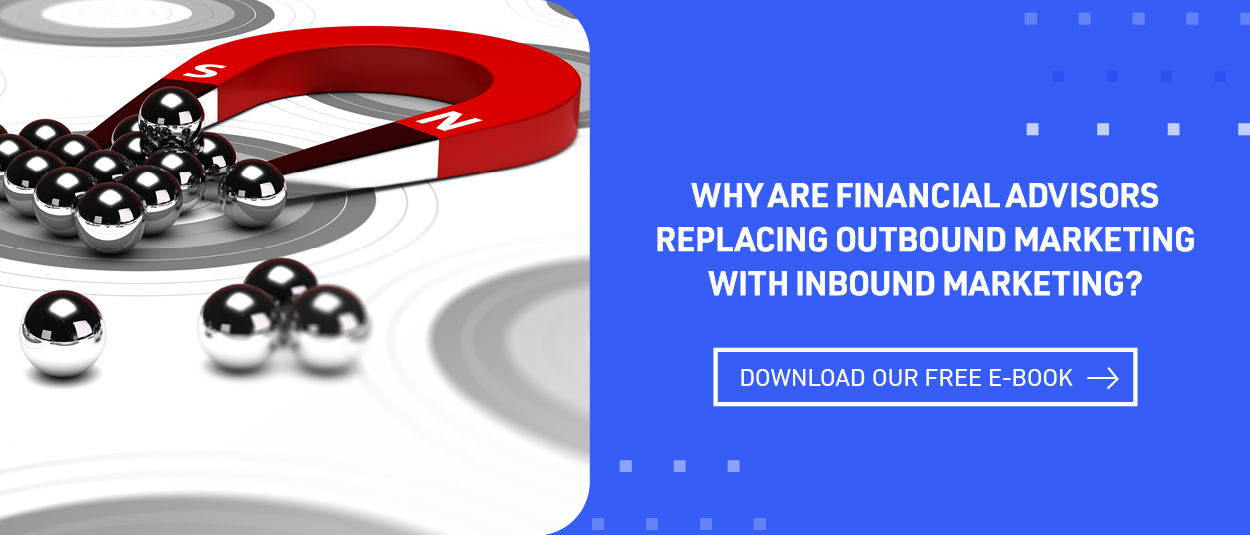

How Financial Advisors Create Lead Generation Landing Pages
You have definitely seen a lot of landing pages but you may not be familiar with their strategic marketing purpose for financial advisors.
Let's say you are visiting a financial advisor website and you see an offer for a free eBook that has an intriguing title. You click on a link, sometimes referred to as a Call To Action (CTA), to register to receive the ebook. This registration process occurs on a landing page that is designed to gather information from investors who want the eBook.
A Value Exchange
The role of the free offer is to create an exchange that has a similar value for both parties. You want the investor’s contact information. The investor wants the information in your eBook. This exchange takes place on your landing page.
The more value you create for investors the higher the probability they will register to gain access to the information thru the landing page.
The Safety Factor
When you ask investors for their contact information it is imperative that they feel safe giving you that information. This means they have to know what you will and will not do with their information.
For example, you will only use their information to respond to their request for information. Your response could be a telephone call, an email, or both.
You may also communicate you will stay in touch with them by adding them to your email list. Make sure you let them know they can unsubscribe from this list at any time.
Make it very explicit that you will not provide their contact information to any other firm or professional. This could be one of their biggest fears that would cause them to withhold their information.
You may also want to provide a link to your firm’s Privacy Policy that describes how you protect investors’ contact information. If you do not have a Privacy Policy you should think about adding one.
The safer you make investors feel, the higher the probability they will “feel” comfortable providing their contact information.
Landing Page Sales Tactics
You could assume that investors saw something on your website that compelled them to click on a CTA that took them to a landing page. They have already made up their minds they want to register for your free offer.
On the other hand, this could be a bad assumption. Perhaps they need some additional convincing before they are willing to register to get your free offer.
Therefore, you may be better off adding content to the landing page that reinforces the benefits of the offer that they are responding to.
For example, add four bullet points that describe the key features and benefits of the offer - for example, a free eBook that covers an important retirement planning topic. What do they have to gain if they register?
The Best Free Offers
Let’s assume the best free offer is an eBook or webinar that addresses a frequent retirement pain point or concern. For example, how about recent retirees being concerned about running out of money late in life when they need it the most.
This is a common concern for investors who have not saved enough money for their retirement years. Perhaps they are considering deferred retirements or part-time jobs to supplement their retirement savings.
You can see how this free offer would resonate with large numbers of investors. Even if they did not have this concern they may be interested in the content because a friend, associate, or family member has this problem.
The more compelling the free offer the higher the probability visitors on your financial advisor website will give-up their anonymity to get it.
What is Excess Information?
A core purpose of a landing page is to obtain the contact information of visitors to your website.
Financial advisors should gather the minimum amount of information they need to follow-up with investors. Most of this is based on common sense: Name, Location, Email, and Telephone.
So what is excess information?
An example would be using a landing page to screen investors. Let’s say your minimum asset requirement is $1,000,000 so you want to limit registrations for the free offer to investors who have that amount available for investors. Or, you ask other questions investors may not be comfortable responding to.
Target Marketing
Another form of excess information is your target marketing. For example, your landing page states you work with investors who are recently retired.
This type of statement excludes all investors who are not recently retired. Or, your landing page says you work with business owners to the exclusion of all investors who are not business owners.
Target marketing is a key characteristic of digital marketing, but it pays to be cautious about what you say on your landing pages. You do not want to exclude anyone you may want to work with.
What About Follow-up?
Assuming your landing page requires email addresses and telephone numbers to receive the free offer, you have a choice for how you will follow-up with investors. You can call, email, or both.
Keep in mind a lot of people registering for eBooks are seeking information and not financial advisors, at least not right now.
Notwithstanding their interests or financial characteristics, everyone who submits their contact information is worth a telephone call. If you have a large volume of leads you may want to assign the follow-up to a junior person at your firm.
If this works for your firm, then there is no reason to use the landing page to screen investors - if you are going to call them anyway. The call can be used to qualify them and determine their future needs for financial advice.

Jack Waymire, BA, MBA
Search Here
Categories
- AI (18)
- blogging (2)
- branding (1)
- content (12)
- custodians (1)
- Digital (345)
- email marketing (3)
- fcmo (2)
- fees (1)
- financial advisor marketing (62)
- Google (3)
- Ideas & Tips (78)
- Investor Experience (7)
- lead generation (7)
- linkedin (1)
- Marketing (371)
- newsletters (1)
- Online Transparency (2)
- search engine optimization (3)
- seo (9)
- Social Media (2)
- video (2)
- Websites (108)
- YouTube channel (2)
Recent Posts
-

-

How Financial Advisor Blogging Generates Thought Leadership and Leads
November 24, 2025 -

Top 5 Ways Digital Marketing Benefits Financial Advisors Seeking Leads
November 20, 2025 -

Trust Is The Biggest Online Marketing Challenge For Financial Advisors
November 17, 2025 -

Compliant Financial Advisor Bios Using AI Website Builders
October 22, 2025

